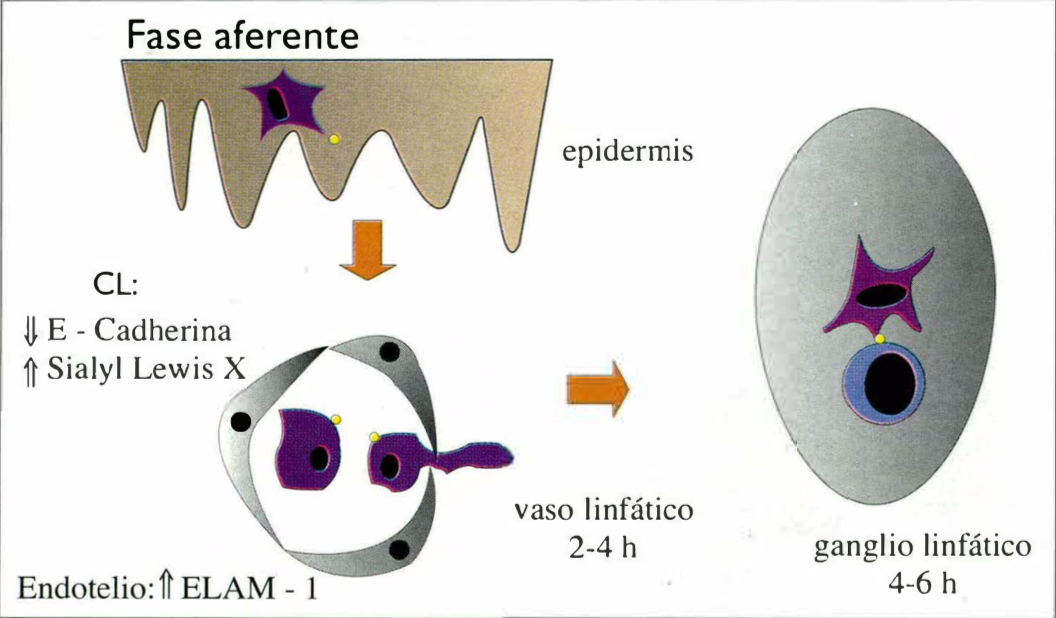Dermatitis de contacto alérgica
Palabras clave:
dermatitis, contacto, alérgica, haptenoResumen
La dermatitis de contacto alérgica (DCA) es una de las causas más frecuentes de consulta en dermatología, de origen exógeno, originada por la exposición a un alergeno, y el desarrollo subsecuente de una reacción de hipersensibilidad tipo 4 frente a futuras exposiciones ante el mismo alergeno.
Biografía del autor/a
Ana Francisca Ramírez, Universidad del Valle
R II Dermatología, Universidad del Valle, Cali, Colombia.
Referencias bibliográficas
2. Belsito D. Allergic Contact Dermatitis. Fitzpatrick's Dermatology in General Medicine. 5a. ed, 1999; 1447-1459.
3. Robert C, Kupper T. lnflammatory skin diseases, T cells and immune surveillance. N England J Med 1998;341:1817-1827.
https://doi.org/10.1056/NEJM199912093412407
4. Kondo S, Sauder D. Epidermal cytokines in allergic contact dermatitis. J Am Acad Dermatol 1995; 33:786-800.
https://doi.org/10.1016/0190-9622(95)91817-5
5. Yawalkar N, Brand C, Braathen L. lnterleukin-12 expression in human afferent lymph derived from the induction phase of allergic contact dermatitis. Brit J Dermatol 1998;138:297-300.
https://doi.org/10.1046/j.1365-2133.1998.02078.x
6. Prosch E, Brasch J. lnfluence of epidermal permeability barrier disruption and Langerhans cell density on allergic contact dermatitis. Acta dermatol Venerol 1997;77:102-104.
7. Viac J et al. Substance P and keratinocyte activation markers: An in vitro aproach. Arch Dermatol Res 1996;299: 85-89.
https://doi.org/10.1007/BF02505049
8. Emtestam L, Zetterquist H, Olerup O. HLA- DR, -DQ and -DP alleles in nickel, chromium, and/or cobalt-sensitive individuals: genomic analysis based on restriction fragment lenght polymorphisms. J lnvest Dermatol 1993;100:271-274.
https://doi.org/10.1111/1523-1747.ep12469732
9. Nossal GJ. Molecular and cellular aspects of immunologic tolerance. Eur J Biochem 1991;202:729-737.
https://doi.org/10.1111/j.1432-1033.1991.tb16427.x
10. Manzini et al. Contact Sensitization in children. Pediat Dermatol 1998;15:12-17.
https://doi.org/10.1046/j.1525-1470.1998.1998015012.x
11. Schah M, Lewis F et al. Patch testing in children and adolescents: 5 years experience and follow-up. J Am Acad Dermatol 1997;37:964-968.
https://doi.org/10.1016/S0190-9622(97)70073-2
12. Marks, Belsito et al. North American Contact Der matitis Group Patch test results for the detection of the delayed type hypersensitivity to topical allergens. J Am Acad Dermatol 1998;38: 911-918.
https://doi.org/10.1016/S0190-9622(98)70587-0
13. Katsarou A, Kalogeromitros M et al. Trends in the results of patch testing to standard allergens over the period of 1984 - 1995. Contact dermatitis 1997: 37: 245-246.
https://doi.org/10.1111/j.1600-0536.1997.tb02452.x
14. Rajgopalan R, Kallal J et al. A retrospective evaluation of patch testing in patients diagnosed with allergic contact dermatitis. Cutis 1996; 57:360-364.
15. Rajgopalan R, Anderson R et al. An economic evaluation of patch testing in the diagnosis and management of allergic contact dermatitis. Am J Contact Dermat 1998 ;9:149-154.
https://doi.org/10.1016/S1046-199X(98)90017-3
16. Funk, Maibach. Horizons in pharmacologic intervention in allergic contact dermatitis. J Am Acad Dermatol 1994;31: 999-1014.
https://doi.org/10.1016/S0190-9622(94)70272-1
17. Di Nardo A, Giusti G et al. lnhibition of the elicitation of contact dermatitis in human by mometasonefuroate: evaluation by means of 20 MHz B scanning associated with image analysis. Dermatol 1997; 195:137-141.
https://doi.org/10.1159/000245716
18. Mitra R, Schimizu Y. Histamine and cis - urocanic acid augment tumor necrosis factor - a mediated induction of keratinocite intercellular adhesion molecule - 1 expression. J Cell Physiol 1993; 156: 348-357.
https://doi.org/10.1002/jcp.1041560218
19. Ho V et al: Cyclosporin in non psoriatic dermatoses. J Acad Dermatol 1990; 23: 1248-1258.
https://doi.org/10.1016/0190-9622(90)70351-H
20. Ruzicka T: Cyclosporin in less common immune - mediated skin diseases. Br J Dermatol 1996; 135:40-42.
https://doi.org/10.1111/j.1365-2133.1996.tb00709.x
21. Meingassner J, Grassberger M et al. A novel antiinfla- mmatory drug, SDZ ASM 981, for the topical and oral treatment of skin diseases: in vivo pharmacology. Br J Dermatol 1997; 137:568-576.
https://doi.org/10.1111/j.1365-2133.1997.tb03788.x
22. Kim T, Kripke M et al. lmmunosuppression by factors realeased from UV irradiated epidermal cells: selected effects on the generation of contact and delayed hypersensitivity after exposure to UVA and UVB radiation. J lnvest Dermatol 1990; 94: 26-32.
https://doi.org/10.1111/1523-1747.ep12873322
23. Zabel P, Schade F. lnhibition of endogenous TNF formation by pentoxifylline. lmmunology 1993; 187: 447-463.
https://doi.org/10.1016/S0171-2985(11)80356-6
24. Schwarz A, Krone C et al. Pentoxifylline suppresses irritant and contact hypersensitivity reactions. J lnvest Dermatol 1993; 101:549-559.
https://doi.org/10.1111/1523-1747.ep12365951
25. Derrene F, Vanhaeverbeek M et al. Nifedipine induced hiporeactivity in delayed hypersensitivity skin tests. lnt J lmmunopharmacol 1987; 9:741- 744.
https://doi.org/10.1016/0192-0561(87)90046-4
26. Morris D. lntradermal testing and Sublingual Desensitization for nickel. Cutis 1998; 61:129- 132.
27. Troost R, Kozel M, et al. Hiposensitization in nickel allergic contact dermatitis: Clínica! and lmmunologic monitoring. J Am Acad Dermatol 1995; 32:576-583.
https://doi.org/10.1016/0190-9622(95)90340-2
28. Bagot M, Terki N et al. Desensitization per os dans !'eczema de contact au nickel: etude clínico - biolo- gique en double insu contre placebo. Ann Dermatol Venereol 1999; 126:502-504.
29. Rheins L, Cotleur A et al. Alpha- melanocyte stimula- ting hormone modulates contact hypersensitivity responsiveness in C57/ BL6 mice. J lnvest Dermatol 1989; 93:511-517.
https://doi.org/10.1111/1523-1747.ep12284064
30. Ameisen J, Meade R. A new interpretation of the involvement of serotonin in delayed type hipersensitivity; serotonin- 2 receptor antagonists inhibit contact sensitivity by an effect on T cells. J lmmunol 1989; 142: 3171-3179.
31. Meng X, Sawamura D et al. Keratinocyte gene therapy for systemic diseases. Circulating IL1O released from gene transferred keratinocytes inhibits contact hypersensitivity at distant areas of the skin. J Clin lnvest 1998; 101:1462-1467.
https://doi.org/10.1172/JCI1031
Cómo citar
Descargas

Descargas
Publicado
Cómo citar
Número
Sección
| Estadísticas de artículo | |
|---|---|
| Vistas de resúmenes | |
| Vistas de PDF | |
| Descargas de PDF | |
| Vistas de HTML | |
| Otras vistas | |






